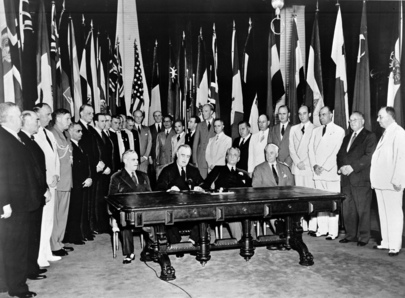1942 “Declaration of United Nations” by the Allies of World War II
Main article: Declaration by United Nations
1943 sketch by Franklin Roosevelt of the UN original three branches: The Four Policemen, an executive branch, and an international assembly of forty UN member states
The earliest concrete plan for a new world organization began under the aegis of the U.S. State Department in 1939. The text of the “Declaration by United Nations” was drafted at the White House on 29 December 1941, by President Franklin D. Roosevelt, Prime Minister Winston Churchill, and Roosevelt aide Harry Hopkins. It incorporated Soviet suggestions but left no role for France. “Four Policemen” was coined to refer to four major Allied countries, United States, United Kingdom, Soviet Union, and Republic of China, which emerged in the Declaration by United Nations. Roosevelt first coined the term United Nations to describe the Allied countries.[a] “On New Year’s Day 1942, President Roosevelt, Prime Minister Churchill, Maxim Litvinov, of the USSR, and T. V. Soong, of China, signed a short document which later came to be known as the United Nations Declaration, and the next day the representatives of twenty-two other nations added their signatures.”[16]
The term United Nations was first officially used when 26 governments signed this Declaration. One major change from the Atlantic Charter was the addition of a provision for religious freedom, which Stalin approved after Roosevelt insisted.[17][18] By 1 March 1945, 21 additional states had signed.[19]
A JOINT DECLARATION BY THE UNITED STATES OF AMERICA, THE UNITED KINGDOM OF GREAT BRITAIN AND NORTHERN IRELAND, THE UNION OF SOVIET SOCIALIST REPUBLICS, CHINA, AUSTRALIA, BELGIUM, CANADA, COSTA RICA, CUBA, CZECHOSLOVAKIA, DOMINICAN REPUBLIC, EL SALVADOR, GREECE, GUATEMALA, HAITI, HONDURAS, INDIA, LUXEMBOURG, NETHERLANDS, NEW ZEALAND, NICARAGUA, NORWAY, PANAMA, POLAND, SOUTH AFRICA, YUGOSLAVIA
The Governments signatory hereto,
Having subscribed to a common program of purposes and principles embodied in the Joint Declaration of the President of the United States of America and the Prime Minister of Great Britain dated August 14, 1941, known as the Atlantic Charter,
Being convinced that complete victory over their enemies is essential to defend life, liberty, independence and religious freedom, and to preserve human rights and justice in their own lands as well as in other lands and that they are now engaged in a common struggle against savage and brutal forces seeking to subjugate the world,
DECLARE:
Each Government pledges itself to employ its full resources, military or economic, against those members of the Tripartite Pact and its adherents with which such government is at war.
Each Government pledges itself to cooperate with the Governments signatory hereto and not to make a separate armistice or peace with the enemies.
The foregoing declaration may be adhered to by other nations which are, or which may be, rendering material assistance and contributions in the struggle for victory over Hitlerism.
The Washington Conference 1941–1942
During the war, “the United Nations” became the official term for the Allies. To join, countries had to sign the Declaration and declare war on the Axis.

